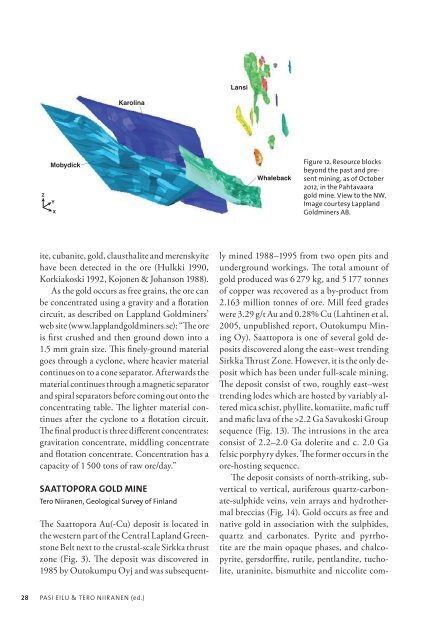Gold deposits in northern Finland - Arkisto.gsf.fi
Gold deposits in northern Finland - Arkisto.gsf.fi
Gold deposits in northern Finland - Arkisto.gsf.fi
Create successful ePaper yourself
Turn your PDF publications into a flip-book with our unique Google optimized e-Paper software.
Lansi<br />
Karol<strong>in</strong>a<br />
Z<br />
Mobydick<br />
Y<br />
X<br />
Whaleback<br />
Figure 12. Resource blocks<br />
beyond the past and present<br />
m<strong>in</strong><strong>in</strong>g, as of October<br />
2012, <strong>in</strong> the Pahtavaara<br />
gold m<strong>in</strong>e. View to the NW.<br />
Image courtesy Lappland<br />
<strong>Gold</strong>m<strong>in</strong>ers AB.<br />
ite, cubanite, gold, clausthalite and merenskyite<br />
have been detected <strong>in</strong> the ore (Hulkki 1990,<br />
Korkiakoski 1992, Kojonen & Johanson 1988).<br />
As the gold occurs as free gra<strong>in</strong>s, the ore can<br />
be concentrated us<strong>in</strong>g a gravity and a flotation<br />
circuit, as described on Lappland <strong>Gold</strong>m<strong>in</strong>ers’<br />
web site (www.lapplandgoldm<strong>in</strong>ers.se): “The ore<br />
is <strong>fi</strong>rst crushed and then ground down <strong>in</strong>to a<br />
1.5 mm gra<strong>in</strong> size. This f<strong>in</strong>ely-ground material<br />
goes through a cyclone, where heavier material<br />
cont<strong>in</strong>ues on to a cone separator. Afterwards the<br />
material cont<strong>in</strong>ues through a magnetic separator<br />
and spiral separators before com<strong>in</strong>g out onto the<br />
concentrat<strong>in</strong>g table. The lighter material cont<strong>in</strong>ues<br />
after the cyclone to a flotation circuit.<br />
The f<strong>in</strong>al product is three different concentrates:<br />
gravitation concentrate, middl<strong>in</strong>g concentrate<br />
and flotation concentrate. Concentration has a<br />
capacity of 1 500 tons of raw ore/day.”<br />
Saattopora gold m<strong>in</strong>e<br />
Tero Niiranen, Geological Survey of F<strong>in</strong>land<br />
The Saattopora Au(-Cu) deposit is located <strong>in</strong><br />
the western part of the Central Lapland Greenstone<br />
Belt next to the crustal-scale Sirkka thrust<br />
zone (Fig. 3). The deposit was discovered <strong>in</strong><br />
1985 by Outokumpu Oyj and was subsequently<br />
m<strong>in</strong>ed 1988–1995 from two open pits and<br />
underground work<strong>in</strong>gs. The total amount of<br />
gold produced was 6 279 kg, and 5 177 tonnes<br />
of copper was recovered as a by-product from<br />
2.163 million tonnes of ore. Mill feed grades<br />
were 3.29 g/t Au and 0.28% Cu (Laht<strong>in</strong>en et al.<br />
2005, unpublished report, Outokumpu M<strong>in</strong><strong>in</strong>g<br />
Oy). Saattopora is one of several gold <strong>deposits</strong><br />
discovered along the east–west trend<strong>in</strong>g<br />
Sirkka Thrust Zone. However, it is the only deposit<br />
which has been under full-scale m<strong>in</strong><strong>in</strong>g.<br />
The deposit consist of two, roughly east–west<br />
trend<strong>in</strong>g lodes which are hosted by variably altered<br />
mica schist, phyllite, komatiite, ma<strong>fi</strong>c tuff<br />
and ma<strong>fi</strong>c lava of the >2.2 Ga Savukoski Group<br />
sequence (Fig. 13). The <strong>in</strong>trusions <strong>in</strong> the area<br />
consist of 2.2–2.0 Ga dolerite and c. 2.0 Ga<br />
felsic porphyry dykes. The former occurs <strong>in</strong> the<br />
ore-host<strong>in</strong>g sequence.<br />
The deposit consists of north-strik<strong>in</strong>g, subvertical<br />
to vertical, auriferous quartz-carbonate-sulphide<br />
ve<strong>in</strong>s, ve<strong>in</strong> arrays and hydrothermal<br />
breccias (Fig. 14). <strong>Gold</strong> occurs as free and<br />
native gold <strong>in</strong> association with the sulphides,<br />
quartz and carbonates. Pyrite and pyrrhotite<br />
are the ma<strong>in</strong> opaque phases, and chalcopyrite,<br />
gers dorf<strong>fi</strong>te, rutile, pentlandite, tucholite,<br />
urani nite, bismuthite and niccolite com<br />
28 Pasi Eilu & Tero Niiranen (ed.)
















